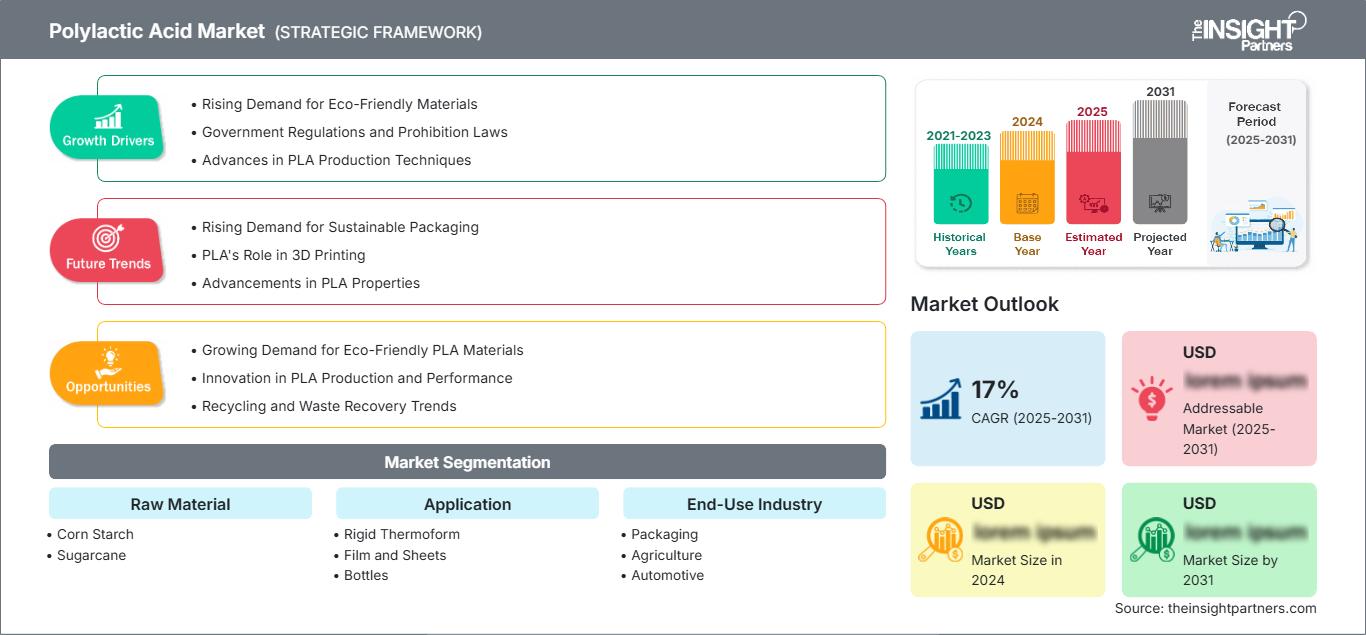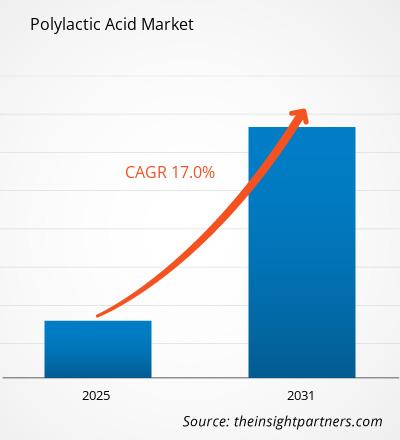Si prevede che il mercato dell'acido polilattico registrerà un CAGR del 17% dal 2025 al 2031, con una dimensione del mercato in espansione da XX milioni di dollari nel 2024 a XX milioni di dollari entro il 2031.
Il rapporto sul mercato dell'acido polilattico è segmentato per materia prima (amido di mais, canna da zucchero, altre). Il mercato è segmentato in base all'applicazione (termoformati rigidi, film e fogli, bottiglie e altri). Il mercato è segmentato in base al settore di utilizzo finale (imballaggio, agricoltura, automotive, elettronica, tessile, beni di consumo, biomedicale e altri). L'analisi globale è ulteriormente suddivisa a livello regionale e per i principali paesi. Le dimensioni e le previsioni del mercato a livello globale, regionale e nazionale per tutti i principali segmenti di mercato sono trattate nell'ambito di applicazione. Il rapporto fornisce il valore in USD per l'analisi, i segmenti, le regioni e i paesi sopra indicati. Il rapporto copre le tendenze del mercato, nonché le dinamiche di mercato come fattori trainanti, vincoli e opportunità chiave. Il rapporto include anche un'analisi del panorama industriale e della concorrenza, che include concentrazione del mercato, analisi delle mappe di calore, attori di spicco e recenti sviluppi del mercato.
Scopo del rapporto
Il rapporto "Polylactic Acid Market" di The Insight Partners mira a descrivere il panorama attuale e la crescita futura, i principali fattori trainanti, le sfide e le opportunità. Ciò fornirà spunti di riflessione a vari stakeholder aziendali, tra cui:
- Fornitori/Produttori di tecnologia: per comprendere le dinamiche di mercato in evoluzione e conoscere le potenziali opportunità di crescita, consentendo loro di prendere decisioni strategiche informate.
- Investitori: per condurre un'analisi completa delle tendenze in merito al tasso di crescita del mercato, alle proiezioni finanziarie di mercato e alle opportunità presenti lungo la catena del valore.
- Enti di regolamentazione: per regolamentare le politiche e le attività di controllo sul mercato con l'obiettivo di ridurre al minimo gli abusi, preservare la fiducia degli investitori e sostenere l'integrità e la stabilità del mercato.
Segmentazione del mercato dell'acido polilattico, materia prima
- Amido di mais
- Canna da zucchero
Applicazione
- Termoformato rigido
- Film e fogli
- Bottiglie
Industria di utilizzo finale
- Imballaggio
- Agricoltura
- Automotive
- Elettronica
- Tessile
- Beni di consumo
- Biomedicina
Geografia
- Nord America
- Europa
- Asia-Pacifico
- America meridionale e centrale
- Medio Oriente e Africa
Potrai personalizzare gratuitamente qualsiasi rapporto, comprese parti di questo rapporto, o analisi a livello di paese, pacchetto dati Excel, oltre a usufruire di grandi offerte e sconti per start-up e università
Mercato dell'acido polilattico: Approfondimenti strategici

- Ottieni le principali tendenze chiave del mercato di questo rapporto.Questo campione GRATUITO includerà l'analisi dei dati, che vanno dalle tendenze di mercato alle stime e alle previsioni.
Fattori di crescita del mercato dell'acido polilattico
- Crescente domanda di materiali ecocompatibili: la crescente necessità di materiali ecocompatibili è dovuta alla crescente preoccupazione ambientale tra consumatori e aziende che non vogliono utilizzare materie plastiche convenzionali. In questo materiale, di origine biologica e compostabile, un'alternativa è l'acido polilattico. Le industrie sono alla ricerca di modi per ridurre lo shock degli inventori, mantenendo al contempo i propri obiettivi. Pertanto, il PLA viene utilizzato sempre di più per applicazioni di tessitura.
- Regolamenti governativi e leggi proibizioniste: ogni governo del mondo ha emanato una serie di norme che, tuttavia, affrontano il problema dello spreco di plastica e promuovono l'uso di materiali biodegradabili alternativi, come la lacca di plastica. Le leggi proibizioniste sull'uso di determinati polimeri, come i sacchetti di plastica monouso, e la promozione di prodotti e produzione di plastica di origine vegetale, sono tendenze che contribuiscono ad aumentare la domanda di PLA. Questi approcci non si concentrano solo sui consumatori, ma anche sui produttori, tenendo presente che tutti questi prodotti vengono forniti ai consumatori.
- Progressi nelle tecniche di produzione del PLA: alcuni miglioramenti nelle pratiche di produzione dell'acido polilattico, ad esempio, tecniche di fermentazione modificate e metodi di produzione più efficaci, stanno rendendo il prodotto più accessibile ed economico da produrre. I progressi tecnologici si traducono in costi di produzione inferiori grazie a rese più elevate del PLA, rendendolo più economico sul mercato rispetto alle plastiche convenzionali ricavate da combustibili fossili.
Tendenze future del mercato dell'acido polilattico
- Crescente domanda di imballaggi sostenibili: si prevede che il mercato globale del PLA trarrà vantaggio dalla crescente domanda di prodotti di imballaggio sostenibili. Oggigiorno, l'uso del PLA negli imballaggi alimentari, nei cucchiai monouso e in altri prodotti, come dimostra il gigantesco commercio elettronico, e la necessità di imballaggi ecologici per i prodotti continua, se non rapidamente, a crescere. Grazie alla sua composizione, il PLA ha molteplici utilizzi, dalla produzione di pellicole trasparenti, contenitori rigidi, ecc., il che lo rende la bioplastica ideale per imballaggi ecocompatibili.
- Il ruolo del PLA nella stampa 3D: l'industria della stampa 3D è in progressiva crescita e il materiale più comune in questo campo è l'acido polilattico. È un materiale preferito nelle applicazioni di stampa 3D in quanto biodegradabile e facile da stampare, con una buona qualità di stampa. A causa della crescente domanda di personalizzazione dei prodotti e della rapida produzione di prototipi, si prevede che il PLA aumenterà ulteriormente il suo contributo alla stampa 3D, nota anche come produzione additiva, aprendo nuove possibilità in questa particolare categoria di prodotti.
- Progressi nelle proprietà del PLA: le attività relative al PLA hanno anche visto gli scienziati impegnati in sforzi volti a modificare proprietà come la stabilità termica, l'impatto, la barriera all'umidità e la formulazione di vari gradi di PLA. Una di queste tendenze degne di nota è lo sviluppo di leghe e strutture a base di PLA che combinano alcuni vantaggi di diversi polimeri. Questi sviluppi aumenteranno la temperatura di utilizzo del PLA, consentendogli di trovare applicazioni anche in settori più sofisticati come l'automobile e l'elettronica, espandendone il mercato complessivo.
Opportunità di mercato per l'acido polilattico
- Crescente domanda di materiali PLA ecocompatibili: le economie emergenti sono sempre più attente alle problematiche ambientali, il che rappresenta un'opportunità significativa per i consumatori di PLA. I paesi dell'Asia-Pacifico, dell'America Latina e dell'Africa si stanno ora concentrando maggiormente sui materiali ecocompatibili. Pertanto, i produttori di PLA si stanno avventurando in questi settori offrendo materiali biodegradabili in base alle esigenze locali.
- Innovazione nella produzione e nelle prestazioni del PLA: il coinvolgimento di enti di ricerca, istituti scolastici e persino altri settori può incoraggiare l'espansione delle possibilità di utilizzo e produzione del PLA. Queste collaborazioni promettono innovazioni in nuove formulazioni o tecnologie del PLA che aumenteranno le prestazioni dei prodotti e la loro capacità di competere sul mercato.
- Tendenze nel riciclo e nel recupero dei rifiuti: le attuali tendenze verso un'economia circolare offrono opportunità affinché anche i produttori di PLA possano ricorrere al riciclo. È probabile che i consumatori e le aziende attente alle problematiche ambientali saranno in grado di accettare con facilità sistemi a circuito chiuso per i prodotti in PLA. Ciò migliorerà l'ambiente riducendo l'incenerimento del PLA, consentendo il recupero dei rifiuti attraverso il riciclo e il compostaggio, creando così un nuovo mercato per il PLA.
Approfondimenti regionali sul mercato dell'acido polilattico
Le tendenze regionali e i fattori che influenzano il mercato dell'acido polilattico durante il periodo di previsione sono stati ampiamente spiegati dagli analisti di The Insight Partners. Questa sezione illustra anche i segmenti e la geografia del mercato dell'acido polilattico in Nord America, Europa, Asia-Pacifico, Medio Oriente e Africa, America Meridionale e Centrale.
Ambito del rapporto di mercato dell'acido polilattico
| Attributo del rapporto | Dettagli |
|---|---|
| Dimensioni del mercato in 2024 | US$ XX million |
| Dimensioni del mercato per 2031 | US$ XX Million |
| CAGR globale (2025 - 2031) | 17% |
| Dati storici | 2021-2023 |
| Periodo di previsione | 2025-2031 |
| Segmenti coperti |
By Materia prima
|
| Regioni e paesi coperti | Nord America
|
| Leader di mercato e profili aziendali chiave |
|
Densità degli operatori del mercato dell'acido polilattico: comprendere il suo impatto sulle dinamiche aziendali
Il mercato dell'acido polilattico è in rapida crescita, trainato dalla crescente domanda da parte degli utenti finali, dovuta a fattori quali l'evoluzione delle preferenze dei consumatori, i progressi tecnologici e una maggiore consapevolezza dei benefici del prodotto. Con l'aumento della domanda, le aziende stanno ampliando la propria offerta, innovando per soddisfare le esigenze dei consumatori e sfruttando le tendenze emergenti, alimentando ulteriormente la crescita del mercato.

- Ottieni il Mercato dell'acido polilattico Panoramica dei principali attori chiave
Punti di forza
- Copertura completa: il rapporto copre in modo completo l'analisi di prodotti, servizi, tipologie e utenti finali del mercato dell'acido polilattico, fornendo un panorama olistico.
- Analisi di esperti: il rapporto è compilato sulla base della conoscenza approfondita di esperti e analisti del settore.
- Informazioni aggiornate: il rapporto garantisce rilevanza aziendale grazie alla sua copertura di informazioni recenti e tendenze dei dati.
- Opzioni di personalizzazione: questo rapporto può essere personalizzato per soddisfare le esigenze specifiche del cliente e adattarsi in modo appropriato alle strategie aziendali.
Il rapporto di ricerca sul mercato dell'acido polilattico può, quindi, aiutare a guidare il percorso di decodificazione e comprensione dello scenario del settore e delle prospettive di crescita. Sebbene possano esserci alcune preoccupazioni valide, i vantaggi complessivi di questo rapporto tendono a superare gli svantaggi.
- Analisi storica (2 anni), anno base, previsione (7 anni) con CAGR
- Analisi PEST e SWOT
- Valore/volume delle dimensioni del mercato - Globale, Regionale, Nazionale
- Industria e panorama competitivo
- Set di dati Excel
Report recenti
Rapporti correlati
Testimonianze
Motivo dell'acquisto
- Processo decisionale informato
- Comprensione delle dinamiche di mercato
- Analisi competitiva
- Analisi dei clienti
- Previsioni di mercato
- Mitigazione del rischio
- Pianificazione strategica
- Giustificazione degli investimenti
- Identificazione dei mercati emergenti
- Miglioramento delle strategie di marketing
- Aumento dell'efficienza operativa
- Allineamento alle tendenze normative






















 Ottieni un campione gratuito per - Mercato dell'acido polilattico
Ottieni un campione gratuito per - Mercato dell'acido polilattico